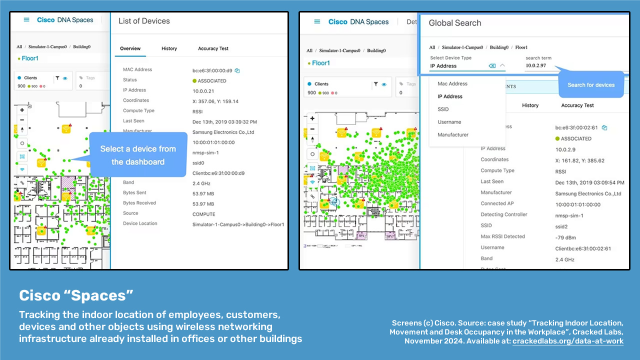The network technology giant Cisco offers to turn Wi-Fi access points installed in offices and other buildings into a system that tracks the location of employees, customers, smartphones, laptops and other devices for a wide range of purposes #workersurveillance
I took a deep dive ⬇️ [thread]

Wolfie Christl
in reply to Wolfie Christl • • •My new case study published today explores behavioral monitoring and profiling in the workplace, with a focus on indoor location and desk occupancy tracking. It's part of a larger research project on employee surveillance.
Read the full 25-page study here:
crackedlabs.org/en/data-work/p…
Tracking Indoor Location, Movement and Desk Occupancy in the Workplace
Cracked LabsWolfie Christl
in reply to Wolfie Christl • • •To illustrate wider practices, I examined Cisco's 'Spaces' system.
It allows organizations to leverage Cisco's wireless access points and other networking infrastructure to analyze how employees "move throughout their physical spaces" and track their behavior, location and movement patterns.
Wolfie Christl
in reply to Wolfie Christl • • •Employers can see the current location of each device in the building on a map, access data on past movements and search for devices in order to locate them.
Employees who carry these devices can be identified via device IDs and usernames.
The system can also use Bluetooth/BLE for location tracking.
Wolfie Christl
in reply to Wolfie Christl • • •The system provides reports that display aggregate information about people currently located in a building.
In addition, it can categorize people based on their movements and behavioral profiling, and makes it possible to single out and target individuals in several ways.
Wolfie Christl
in reply to Wolfie Christl • • •Cisco promotes a wide range of applications that affect both customers and employees.
Companies can use the system to track and profile customers, make decisions on buildings or staff deployment, or to implement indoor navigation, patient tracking or student attendance tracking at universities.
Wolfie Christl
in reply to Wolfie Christl • • •Wolfie Christl
in reply to Wolfie Christl • • •Cisco describes many applications related to safety and security, e.g. detecting 'unusual asset usage' or employee equipment leaving the facility.
Hospitals can use it to monitor 'hand hygiene compliance'.
Cisco also suggests to use it for performance monitoring in manufacturing.
Wolfie Christl
in reply to Wolfie Christl • • •The system processes indoor location data on a massive scale and frequency.
Cisco claims that it has so far processed 24.7 trillion 'location data points' on almost 100,000 devices collected via 3.8 million Wi-Fi access points installed in offices and other buildings.
Wolfie Christl
in reply to Wolfie Christl • • •The fact that Cisco is able to provide these numbers raises the question about how the company processes the data for its own purposes.
I briefly address this question in section 3.2.6 of my case study, alongside Cisco's claims about privacy, data protection and 'GDPR compliance':
crackedlabs.org/en/data-work/p…
Tracking Indoor Location, Movement and Desk Occupancy in the Workplace
Cracked LabsWolfie Christl
in reply to Wolfie Christl • • •To make things worse, the system can also turn Cisco’s WebEx video conferencing devices and even its security cameras (!) into sensors.
Video camera data can be utilized to analyze the "behavior of people within physical spaces", including employees, students, customers or patients.